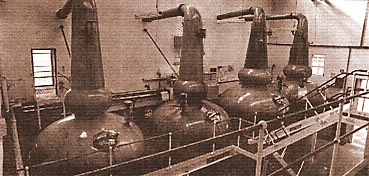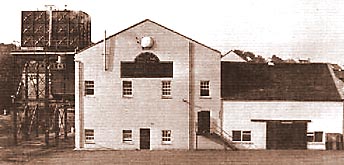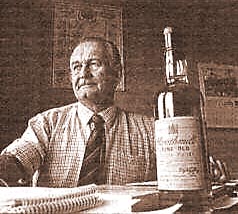I went there to celebrate a centenary, and ended up with two. It was an irresistible coincidence: the one-hundredth distillery to grace the bottling lists of the Scotch Malt Whisky Society just happened to have celebrated its one-hundredth anniversary last year.
We are delighted to have made the century. There are fewer than 100 malt distilleries presently working in Scotland, and only 120 or so whiskies available in cask - if you count the now-matured product of defunct distilleries.
 It is significant also that our
hundredth whisky is so rare as a bottled single malt that it has
eluded even the experts. In his Malt Whisky Companion, Michael
Jackson lists it as one of six which appear never to have been
bottled as singles in recent times, even by independent bottlers.
So mark well our tasting notes on No 100: you are unlikely to see
them elsewhere.
It is significant also that our
hundredth whisky is so rare as a bottled single malt that it has
eluded even the experts. In his Malt Whisky Companion, Michael
Jackson lists it as one of six which appear never to have been
bottled as singles in recent times, even by independent bottlers.
So mark well our tasting notes on No 100: you are unlikely to see
them elsewhere.
Characteristically, the Strathmill Distillery hides itself shyly behind trees in a dip off the main road through the attractive town of Keith, Banffshire. Its boundaries are marked by the northerly River Isla, which runs parallel to the nearby Spey, and by the rusty (but usable) railway line to Dufftown with an ancient siding into the grounds.
River water for cooling, spring water for distilling, rails for Transport, and a sylvan setting. What else could a 19th century whisky-maker ask for? But one intriguing question is this: how long has whisky been made in this perfect location?
 Most authorities say that Strathmill
Distillery was converted from a flour mill in 1891, but was first
called Glenisla-Glenlivet and renamed in 1895 when it was bought
by Gilbey's for £9,500. The flour mill was said to have stood
there since 1823. But another account suggests that the flour
mill itself was a converted distillery building, called
Strathisla, from which the distilling equipment was removed in
1837. To confuse matters further, the present-day
Strathisla-Glenlivet is one of Keith's three other working
distilleries, and was originally called Milltown.
Most authorities say that Strathmill
Distillery was converted from a flour mill in 1891, but was first
called Glenisla-Glenlivet and renamed in 1895 when it was bought
by Gilbey's for £9,500. The flour mill was said to have stood
there since 1823. But another account suggests that the flour
mill itself was a converted distillery building, called
Strathisla, from which the distilling equipment was removed in
1837. To confuse matters further, the present-day
Strathisla-Glenlivet is one of Keith's three other working
distilleries, and was originally called Milltown.
However, the Strathmill Distillery passed to International Distillers & Vintners in 1962 and is operated by Justerini & Brooks. It produces 52,000 alcohol-litres a week, all of which goes into blends (including J&B Rare).
Indeed, the last known record of Strathmill being on sale as a single malt is in a Gilbey's advertisement of 1909. It was bottled at five years old and sold for three shillings (15p to you) with a penny back on the bottle. The agents for Strathmill were family grocer's shops in Elgin, Craigellachie, Rothes and Lossiemouth.
To mark last year's centenary, the two oldest butts in the warehouse - 25 years old - were bottled for employees and fortunate guests. The distillery manager, Randolph Winchester, had a collector on the phone next day offering him £ 250 for his bottle, a proposition he politely declined.
 The manager has worked at the distillery
since 1959: his first jobs were shovelling coal for the stills
and assisting in the cooperage: so he has seen the stills
converted to oil-fired steam heating and the coopers depart.
The manager has worked at the distillery
since 1959: his first jobs were shovelling coal for the stills
and assisting in the cooperage: so he has seen the stills
converted to oil-fired steam heating and the coopers depart.
He has worked in every department at Strathmill. One of the toughest jobs was cleaning the interior of the wooden washbacks with heather brooms (called besoms). First, he even had to go out and pull up the heather. The stalks were then bound to an eight-foot long pole and he stood inside the washbacks, scouring with that besom until his shoulders ached.
Of course, much has happened at Strathmill since. The mashing and fermenting vessels are now of stainless steel and it is, in fact, one of the neatest and cleanest distilleries you could hope to see.
Each week, 126 tonnes of lightly-peated malted barley is delivered by road, often from maltsters in Buckie and Pencaitland. This makes 14 mashes, after the malt has gone through the German-made Miag six-roller mill and been conveyed to the mash-tun in proportions of 15 per cent husks, 77 per cent middles and 8 per cent flour.
There are six 46,500 litre washbacks for fermentation, generated by equal quantities of Maurie and DCl yeast. Entering the wash receiver at 32 degrees C, the liquid has its temperature more than doubled by recycled heat before going through the first distillation.
Strathmill has two pairs of stills. The spirit stills are among the few in the industry fitted with 'purifiers' which retrieve the heavier fusel oils etc and return them to the distillation, while the lighter vapours continue to the main condenser.
With the wash stills taking 45 minutes to come to the boil and the spirit stills one hour, Strathmill performs its miracle on a six-hour cycle. The middle cut comes through at 71 per cent Alcohol by Volume and is reduced with spring water to one of two standards for filling: 68.5 or 63.5.
The magnificent copper stills were smartened up with a coat of lacquer for the centenary - unfortunately, as it turns out. The lacquer has not withstood the heat and has taken on a streaky pinkish look. Mr Winchester may well return to the old practice of having the bare copper rubbed over weekly with vegetable oil, giving a superb burnished appearance.
The Strathmill is matured for 10 to 12 years, in sherry butts or whisky hogsheads, in the low-roofed, earthen-floored warehouses. A typical delivery to the blender will incorporate about 37 per cent from ex-sherry casks.
At this gem of a distillery, I heard the tale of the 'whisky fountain'. In the original buildings, whisky straight from the still was run into open vessels with a mug placed handily 'for any passer-by on friendly terms with the management to help himself'. I looked everywhere but - damn - it was gone.
Unless otherwise noted, all information in this site © The Scotch Malt Whisky Society, Edinburgh, Scotland, 1997.